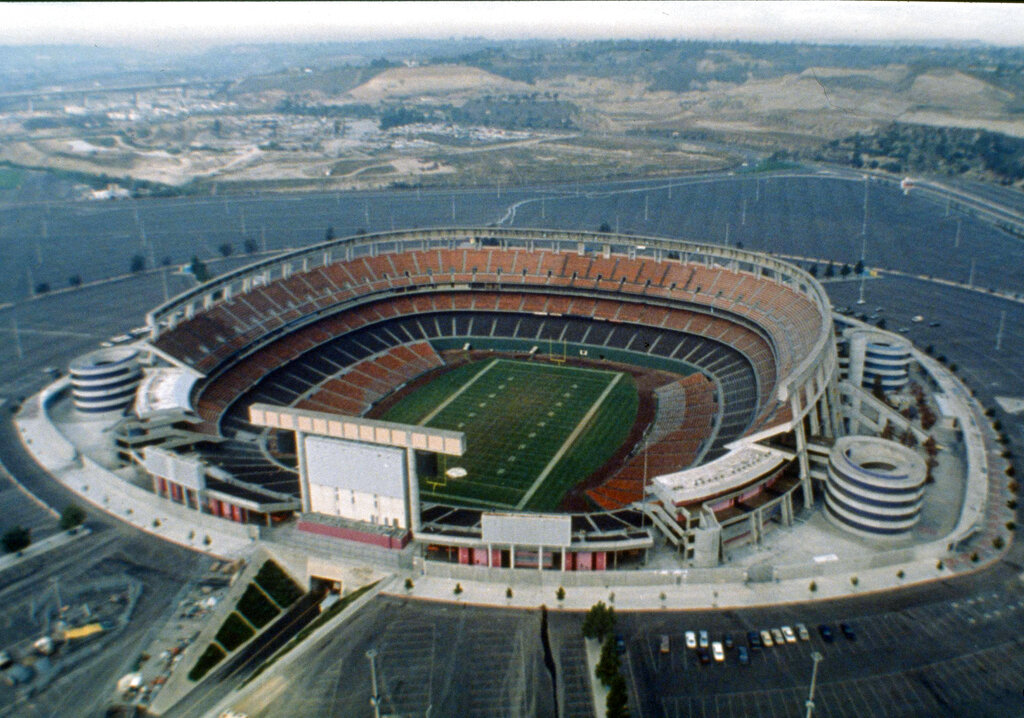How San Diego Changed the Super Bowl Experience 35 Years Ago
Visitors to San Diego enjoy the downtown and Gaslamp Quarter. Both amenities make the downtown area a joy for locals and tourists. San Diego also frequently tops list of best places to live or vacation in the US.
But here’s a little-known fact: Many of the great attractions in San Diego wouldn’t exist if it weren’t for the city’s successful bid for the Super Bowl they hosted 35 years ago. The game ended up lopsided, absent drama. But the legacy of that first game in San Diego lives on all these years later.
Super Bowl XXII, played on Jan. 31, 1988, at Jack Murphy Stadium, remains one of the most successful games in the history of the event, from an economic and public relations standpoint.
How San Diego Got Its First Super Bowl
Prior to the mid-1980s, the Super Bowl had been played primarily in three urban areas: Los Angeles, Miami, and New Orleans.
Through 1983, 15 of the 17 Super Bowls had been played in those three cities (including Pasadena’s Rose Bowl, which is only 10 miles northeast of LA).
But in 1984, the NFL hosted its championship game in Tampa. The league decided to offer other cities a chance to have the game, which is how leaders in San Diego got involved in wooing the NFL.
“We had our eyes on the Super Bowl starting in 1982,” San Diego Mayor Pete Wilson told Sporting News in 1998. “We wouldn’t accept that we couldn’t get the game. In many ways, we were like the little city that could.”
BURNING QUESTION: When Will California Legalize Sports Betting?
In 1983-84, the population of San Diego was less than 900,000, making it far smaller than its northern neighbor (and rival), Los Angeles, and other NFL urban centers. But the city had plans to make itself much bigger in stature.
To sweeten the allure of San Diego, city leaders promised to invest in a revitalization of the downtown area, adding seating areas, public common areas, and attracting restaurants and bars with tax incentives.
This is common strategy today, but in the 1980s, cities didn’t make that big a deal about the Super Bowl. In fact, Pasadena’s leadership had grown tired of the game, and even toyed with the idea of charging the NFL for the hassle of cleaning up the city following the big game.
San Diego’s Presentation
The NFL Super Bowl Committee heard presentations from 14 cities in April and May of 1984. At stake were the rights to host four Super Bowls (XXI, XXII, XXIII, and XXIV). The bidding cities were: Anaheim, Detroit, Houston, Jacksonville, Miami, Minneapolis, New Orleans, Pasadena, Philadelphia, San Francisco, San Diego, Seattle, Tampa, and Tempe.
San Diego’s presentation contained a flourish of artist renditions of a new, vibrant walking corridor through the Gaslamp Quarter downtown. The team planned to add to the seating, restrooms, and concessions at Jack Murphy Stadium, home to the Chargers.
“We expected to be a longshot,” Wilson wrote in his memoir.
Philadelphia was vying to become the first cold-weather city to host an outdoor Super Bowl. Yet, for many, San Diego, tucked way down south in California, with a small airport and no tradition of football success, was an even bigger underdog.
But, San Diego was more prepared than any other presenting city. They trotted out numerous business owners from the city during an enthusiastic presentation. They included Leon Parma from Budweiser, Bob Payne, former COO of Jack in the Box, as well as Herb Klein, editor-in-chief of The San Diego Union-Tribune.
Chargers team owner Gene Klein, who made his millions in insurance and entertainment property leasing, assured his fellow NFL brethren that he would add thousands of parking spaces needed. Klein gave his word on it. He also promised the city would construct a conference center for the purpose of hosting a fan-centric festival leading up to the game.
READ MORE: Our Fliff Same Game Parlay for Super Bowl 57
In a novelty move, San Diego offered the league numerous revenue packages, to share in the millions of dollars that would flood in from activity in and around the stadium. That type of deal had never been offered from officials in LA or Miami.
The folks in San Diego saw the Super Bowl as a partnership with the NFL, not a headache.
That attitude rung true with the millionaires on the committee.
On May 24, 1984, the NFL awarded Super Bowl XXII to San Diego. The game was scheduled for January of 1988, to crown the champion of the 1987 NFL season. The city had less than four years to plan.

4 Years to Prepare for Super Bowl XXII
San Diego proved to have the moxie to deliver on its promises. By the spring of 1987, the Gaslamp Quarter, a historic neighborhood in the heart of the downtown, had been transformed. With refurbished brick facades on many of the buildings, and a new trolley system, visitors could find their way into the Gaslamp Quarter for food, music, drinks, shopping, and more.
When the game arrived on Jan. 31, 1988, it came after a stressful football season that was shortened by a players strike, and marred by the controversy of strike-breaking “replacement players” for three weeks. Nevertheless, the Denver Broncos and Washington Redskins emerged as conference champions and traveled to sunny San Diego, for the first game hosted in a California city other than Los Angeles or its suburb, Pasadena.
Super Bowl XXII was a dud on the field. The Redskins responded to a 10-0 first-quarter deficit by scoring 42 unanswered points. Records were broken, but they were for point differential and favored Washington. The Broncos lost their second consecutive Super Bowl.
But the overall event was a tremendous success. The NFL Fan Experience “festival” promised by Chargers ownership was hugely popular, drawing 250,000 visitors. The idea became a staple of the Super Bowl week going forward.
The game also broke records for ticket sales and stadium revenue. The host committee hosted events galore, including yacht races on the bay with Dennis Conner and Ted Turner; concerts by Frank Sinatra, Liza Minnelli, and Whoopi Goldberg; and fireworks displays on San Diego Bay.
It also extended Super Bowl events into Mexico. The NFL commissioner’s party was held on beautiful Coronado Island.
Changing Everything About the Super Bowl
At midgame, legendary rock and roll pioneer Chubby Checker performed on the field with 88 pianos and The Rockettes dancers. The show was a stark contrast from previous efforts. Prior to the Super Bowl in 1988, most venues had scheduled marching bands or musical review groups for the halftime show. “A Salute to the Big Band Era” had been played at halftime of the 1980 game. In 1987, George Burns, Mickey Rooney, and Disney characters had performed the Super Bowl halftime show in Pasadena.
Checker was a marquee name and a lively rocker compared to the staid entertainment choices for past games.
San Diego, which had previously been seen by many as a “laid-back, who cares?” city, was rebranded as a touristy destination. Most importantly to city officials, San Diego proved itself as a significant operator for large-scale events.
“Our week here (in San Diego) will never be forgotten,” Washington head coach Joe Gibbs said following his team’s victory. “The city was the perfect host. Let’s play this game here every year.”
In succeeding years, San Diego hosted The America’s Cup, as well as the 1996 Republican National Convention, and Comic-Con International (numerous times). Corporations began to utilize that new conference center for annual retreats and large events. None of that could have occurred if San Diego hadn’t won the right to host Super Bowl XXII.
BIG GAME: Top Daily Fantasy Contests for the Super Bowl on California DFS Sites
Why did San Diego prove to be the best host the Super Bowl ever had?
Because it was the first city to see the Super Bowl as something to aspire to. Previously, Pasadena and LA had acted as if they were doing the NFL a favor by hosting the championship game for free in their stadiums.
It was not the last time San Diego was center stage for pro football. Jack Murphy Stadium also hosted Super Bowls XXXII and XXXVII.
